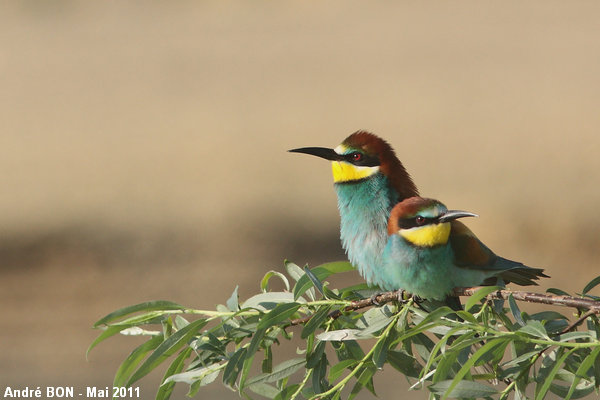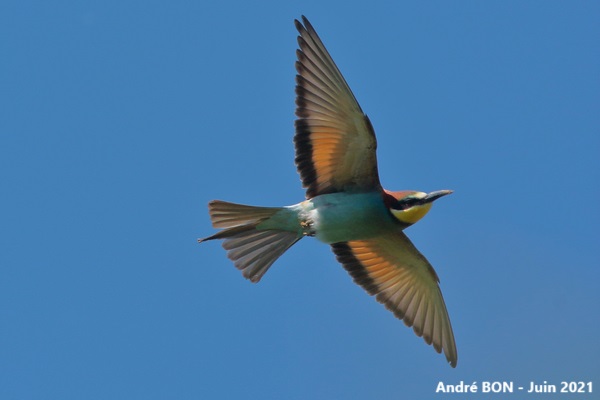











| European Bee-eater (Merops apiaster (Linnaeus, 1758)) |












|
|
Scientific name: Merops apiaster (Linnaeus, 1758) Common name: European Bee-eater French name: Guêpier d'Europe Order: Coraciiformes Family: Meropidae Size: Body size: 27 to 29 cm; Weight: 44 to 78 g; Wingspan: 44 to 49 cm. Habitat: Sandy and friable cliffs bordering rivers, gravel quarries or sand quarries. Food: European Bee-eaters mainly catch their preys in flight: Wasps, bees, hornets and other Hymenoptera, and also dragonflies, butterflies, etc. Nesting: European Bee-eaters nest in variable size colonies. They dig burrows with an oval-shaped section and about 70 to 150 cm long. Females lay about 5 eggs early April. If the first brood fails then the pair will dig another burrow for a second brood. Migration: European Bee-eaters from western Europe migrate to central Africa, those from eastern Europe migrate to South Africa. Asian European Bee-eaters migrate to India and Sri Lanka. Geographic area: Southern and Central Europe, North Africa, South Africa, southern and western Asia during the breeding period. Tropical Africa, South Africa, India and Sri Lanka in winter. |
The European Bee-eater is a bird with a very colourful plumage. It is yellowish brown on the upper side and blue green on the under side. The forehead is white. The red eye is located in a broad black stripe. The throat is bright yellow and bordered below by a black line. The central rectrices extend further than the average end of the tail. The rather long bill is curved. Juveniles are a duller colour. It is very pleasant to hear the typical contact calls of the Bee-eaters in flight and you can often recognize these birds before seeing them. The flight alternates fast wing-beat series and gliding. |
| [To know more about the European Bee-eater] [Next picture] [Top] |

|
Pictures of European Bee-eaters are often shot in the vicinity of nesting locations. I have shoot this picture next to a gravel quarry where a large colony is nesting. An agricultural dirt road passes at a respectable distance and it is close to small shrubs. I have stayed inside my car, hidden behind a camouflage net and I don't think I have disturbed the colony because of the distance. |
| [To know more about the European Bee-eater] [Next picture] [Previous picture] [Top] |

|
These European Bee-eaters had just arrived one of two days ago. I have read that pairs are generally linked for life and that new pairs meet on the winter range. The new formed pairs will fly and nest in the native region of the male. Haven't you notice any kind of Spanish, Italian or other tones in the females' songs? |
| [To know more about the European Bee-eater] [Next picture] [Previous picture] [Top] |

|
I had only one short day available to observe these beautiful birds. I should have had some more free days to have a chance to admire the typical courtship feeding scene when one male offers one insect to a female. |
| [To know more about the European Bee-eater] [Next picture] [Previous picture] [Top] |

|
I still need to make progress on pictures of birds in flight. |
| [To know more about the European Bee-eater] [Next picture] [Previous picture] [Top] |

|
Difficult to make a selection in the series of pictures. Here is another one … |
| [To know more about the European Bee-eater] [Next picture] [Previous picture] [Top] |

|
I have taken this picture at the take off from the perch. There is still some sharpness problems. |
| [To know more about the European Bee-eater] [Next picture] [Previous picture] [Top] |

|
The water level of the Doubs river has been rather high this spring, causing problems to the European Bee-eaters for digging their nests in the earth cliff bordering the river. I found this burrow, about two hundred meters away from the bank of the river, on the side of a path used by cows. This location is more at risk for eventual predators and I do not know if its use was successful. |
| [To know more about the European Bee-eater] [Next picture] [Previous picture] [Top] |

|
The earth cliff that borders the Doubs river presents a danger to the livestock present in the adjacent meadows. A fence is necessary to protect them. This fence must also be moved every year depending on the modification of the meanders of the river during floods. But this fence also has another use, it is a well-placed perch near the colony of European Bee-eaters. |
| [To know more about the European Bee-eater] [Next picture] [Previous picture] [Top] |

|
Here is a photo shot during a second visit to the colony. I think the young of the year have already been born. Around mid-August they will come to fly over my garden less than 2 kilometres away before leaving on migration. Just listen carefully, you often hear them before you see them. |
| [To know more about the European Bee-eater] [Next picture] [Previous picture] [Top] |

|
I'm getting a little better at photos of birds in flight. I still have to improve the framing and choose a better time so that the sun's rays are in the right direction. Secondly, I will try to find a location that allows for a background other than the blue sky (while remaining at a distance so as not to disturb the colony). |
| [To know more about the European Bee-eater] [Next picture] [Previous picture] [Top] |

|
The European Bee-eater is a very photogenic bird. For a beautiful photo you also need a beautiful perch. This one is not the best effect. The winter floods will perhaps bring me another one for next year. |
| [To know more about the European Bee-eater] [Previous picture] [Top] |

|
Some photographers erase unwanted elements from their images such as these small oblique or lower left branches. I prohibit myself from this type of modification. |